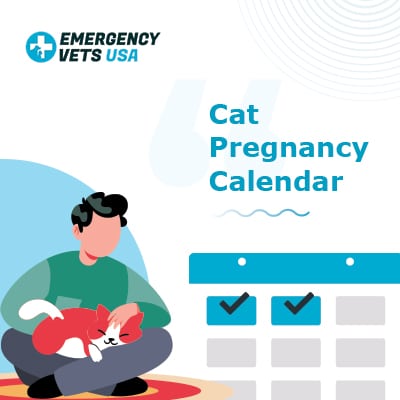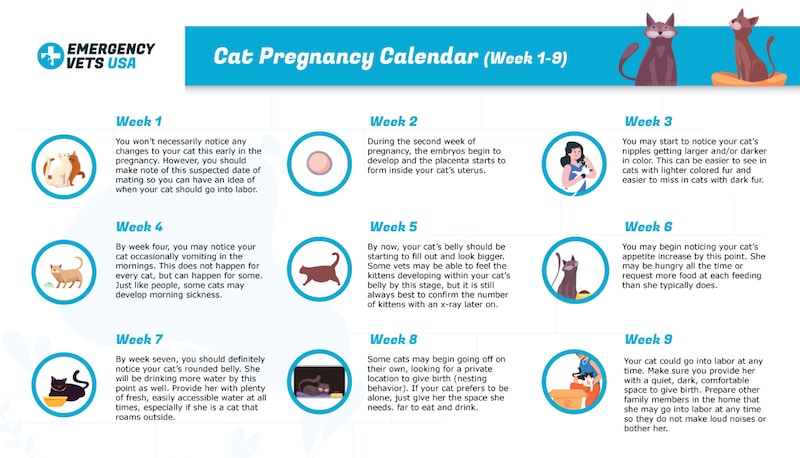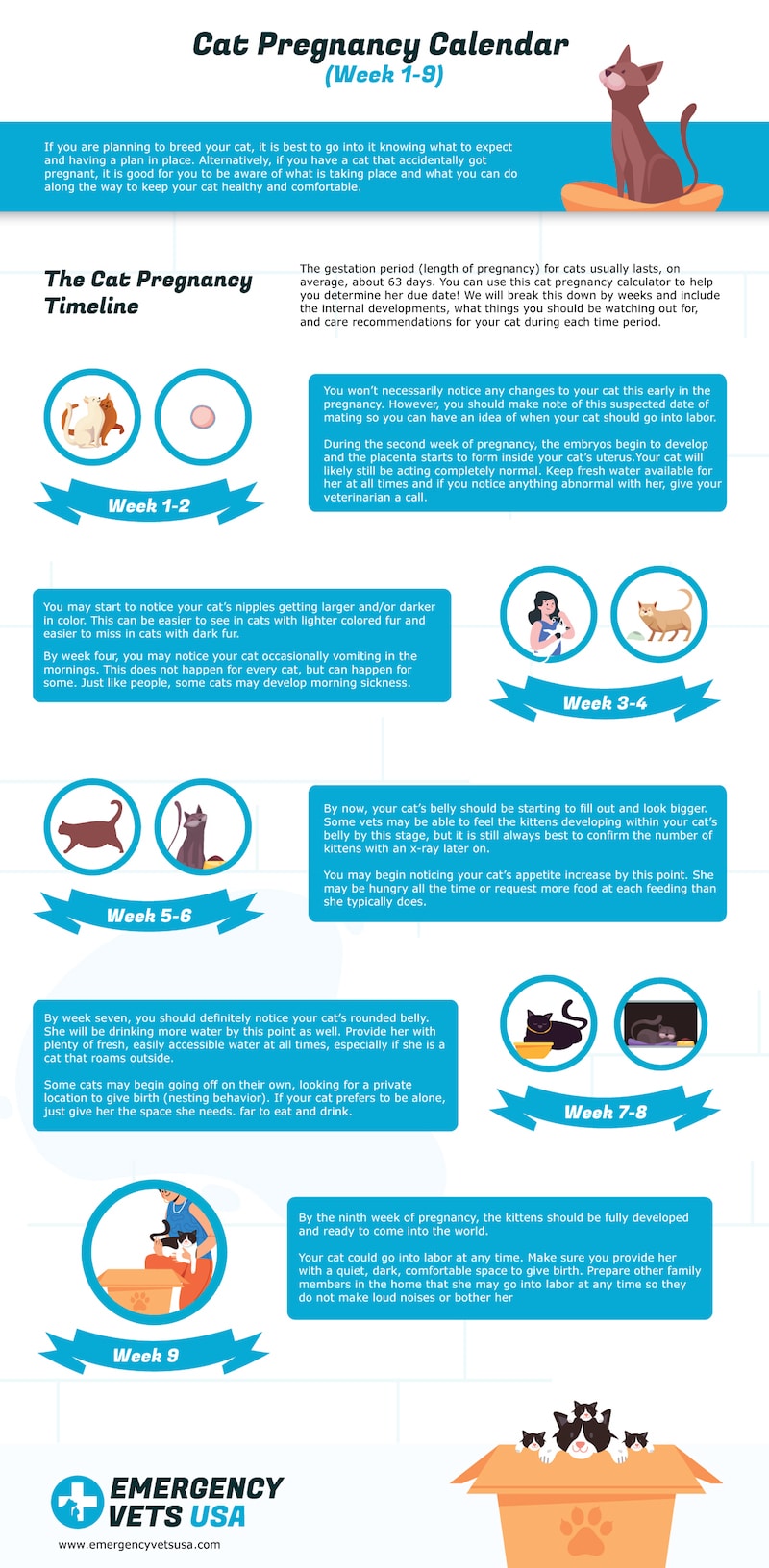Cat Pregnancy Calendar
If you are planning to breed your cat, it is best to go into it knowing what to expect and having a plan in place.
Alternatively, if you have a cat that accidentally got pregnant, it is good for you to be aware of what is taking place and what you can do along the way to keep your cat healthy and comfortable.
That is exactly what we will discuss in this article, a week by week guide on what is going on inside your cat during her pregnancy.
Being prepared and know how you can help her along the way is important to her health and the health of her babies.
The Cat Pregnancy Timeline

The gestation period (length of pregnancy) for cats usually lasts, on average, about 63 days.
You can use this cat pregnancy calculator to help you determine her due date.
We will break this down by weeks and include the internal developments, what things you should be watching out for, and care recommendations for your cat during each time period.
Week 1
Since cats can go into heat often and unexpectedly, it is very easy for cats to become pregnant.
They can even be impregnated by multiple males, contributing to one pregnancy.
This is one reason why you may get kittens that have a variety of fur colors and patterns in one litter.
Cats are also induced ovulators, which means a female cat release eggs from her ovaries during a sexual encounter, which also makes it easier for her to become pregnant.
After mating, the male cat’s sperm will attach to the eggs. The fertilized egg(s) will then be implanted into your cat’s uterus.
You won’t necessarily notice any changes to your cat this early in the pregnancy.
However, you should make note of this suspected date of mating so you can have an idea of when your cat should go into labor.
Week 2
During the second week of pregnancy, the embryos begin to develop and the placenta starts to form inside your cat’s uterus.
Your cat will likely still be acting completely normal.
Keep fresh water available for her at all times and if you notice anything abnormal with her, give your veterinarian a call.
Week 3
During week three, the developing kittens begin to form their internal organs, brain, legs, and circulatory system. So much is going on during this week!
You may start to notice your cat’s nipples getting larger and/or darker in color.
This can be easier to see in cats with lighter colored fur and easier to miss in cats with dark fur.
That being said, some cats will also begin to lose the fur around their nipples. This makes it easier for the kittens to nurse.
If you haven’t already, by week three, you should have your cat examined by their veterinarian.
Your vet can make sure your cat is in a good body condition and health status.
This is important so you can know if there are any nutritional changes you should make to your cat’s regular feeding routine to ensure optimal health throughout pregnancy.
If your vet has an ultrasound, they can confirm pregnancy by looking for the kittens’ heartbeats inside her belly.
Don’t expect a kitten count at this time, though. Ultrasounds are great at confirming pregnancy, but they are not good at counting the number of kittens that are present.
Week 4
During the fourth week of pregnancy, the kittens’ skeletons and nervous system develop more, as they go from being an embryo to a fetus.
By week four, you may notice your cat occasionally vomiting in the mornings.
This does not happen for every cat, but can happen for some. Just like people, some cats may develop morning sickness.
This usually happens if they go for a long period of time without eating.
Offering your cat frequent, small meals throughout the day can help decrease the vomiting and nausea.
Some cats in this stage of pregnancy will also have a decreased appetite and may not eat as much as they usually do.
If your cat is vomiting frequently or the vomiting does not subside within a week, you should have them examined by your veterinarian.
Week 5
By the fifth week of pregnancy, the kittens’ nerves and muscles are developing.
With development of muscles, they can begin moving and kicking some within the uterus.
By now, your cat’s belly should be starting to fill out and look bigger.
Some vets may be able to feel the kittens developing within your cat’s belly by this stage, but it is still always best to confirm the number of kittens with an x-ray later on.
Determining the number of kittens by palpation alone can sometimes be misleading, as the uterus also begins to fill with fluid, making it difficult to feel each individual kitten.
It is a good idea at this point to start adding in kitten food to your cat’s regular diet.
Kitten food is higher in calories and nutrients, which will help the kittens to grow and meet the increased energy needs of the mother cat.
Week 6
During the sixth week of pregnancy, the kittens’ skin starts to get thicker while their tails start to lengthen.
You may begin noticing your cat’s appetite increase by this point.
She may be hungry all the time or request more food at each feeding than she typically does.
Her nutrient requirements are one and a half times more than they were prior to her pregnancy.
With her uterus getting bigger and therefore less room for her stomach to fill with food, feed her multiple small meals throughout the day.
As mentioned before, add in some kitten food to the mix as well. If she asks for more food, go ahead and give her more.
Week 7
During the seventh week of pregnancy, the kittens’ fur develops more, covering their tiny bodies.
By week seven, you should definitely notice your cat’s rounded belly.
She will be drinking more water by this point as well. Provide her with plenty of fresh, easily accessible water at all times, especially if she is a cat that roams outside.
After the 45th day of pregnancy, your vet can do an x-ray of your cat’s belly to count how many kittens are present.
This will help you prepare for her birthing process as well as know how many kittens to expect.
Week 8
As week eight approaches, it is getting closer and closer to kitten delivery day.
Your cat will be obviously pregnant with a rounded belly. She will also begin to lose more of the fur around her nipples.
She may start grooming herself more, but may have difficulty due to her large belly. Your cat’s mammary glands may also be enlarged by this week.
You can help her by brushing her and using a damp, warm washrag to gently clean her vulva and the skin on her stomach.
She may start acting more needy by now, so just give her all the love and attention you can.
Some cats may begin going off on their own, looking for a private location to give birth (nesting behavior).
If your cat prefers to be alone, just give her the space she needs.
Put her food and water bowls near where she prefers to be so she doesn’t have to venture out far to eat and drink.
Week 9
By the ninth week of pregnancy, the kittens should be fully developed and ready to come into the world.
Your cat could go into labor at any time.
Make sure you provide her with a quiet, dark, comfortable space to give birth.
Prepare other family members in the home that she may go into labor at any time so they do not make loud noises or bother her.
Her appetite might start to decrease some and she may begin to act restless and vocalize more.
If it doesn’t stress her out too much, you can check her temperature a few times a day.
This way you can get a baseline of her normal temperature, because when her temperature drops by about one degree, it usually indicates labor will begin soon.

Signs Your Cat Is Going Into Labor
Now that your cat has made it to the full term of pregnancy, you need to keep a close eye on signs that your cat may be going into labor.
If at any point you are worried about your cat or if she hasn’t started labor and it has been more than 70 days since her mating, you need to take her to your veterinarian for an exam.
Signs your cat is starting to go into labor:
- Body temperature decreases about 1 degree (to below 100 degrees Fahrenheit) – indicates labor will start within 12-24 hours
- Decreased appetite
- Increased vocalization and restlessness
- Looking for an isolated place to hide
- Minor vulvar discharge
When your cat begins labor, give her privacy.
Check in on her periodically to make sure she is okay, but do not stress her out, as this can cause complications with her delivery.
Your cat will look for a place to give birth. No matter where she chooses, DO NOT move her or any new born kittens before or during delivery.
If you move her or cause stress during the delivery you will find that some or many of the kittens will not survive.


Leslie Brooks graduated from the University of Tennessee College of Veterinary Medicine in 2012. After graduation she moved to Indianapolis to do an intensive one-year internship at a specialty practice and then began working as a small animal general practitioner. She ran her own house call practice for three years, visiting pets in people’s homes. Currently, she works part time in clinical practice and volunteering her free time to serve pets of the homeless. Read more about us here.
